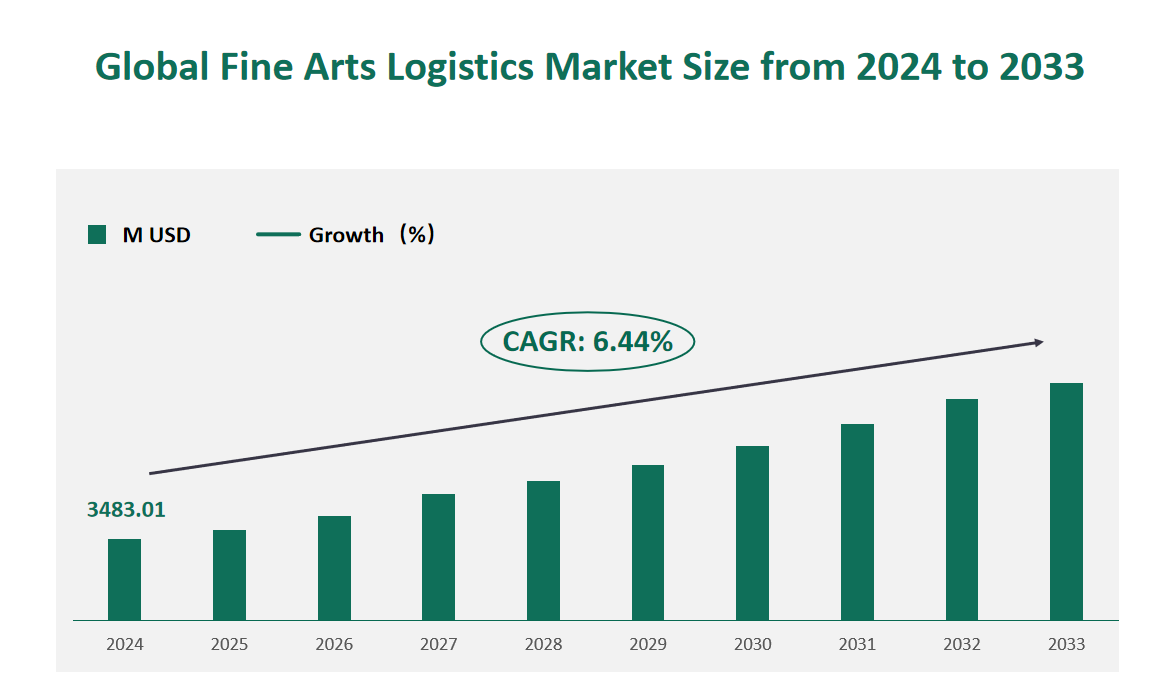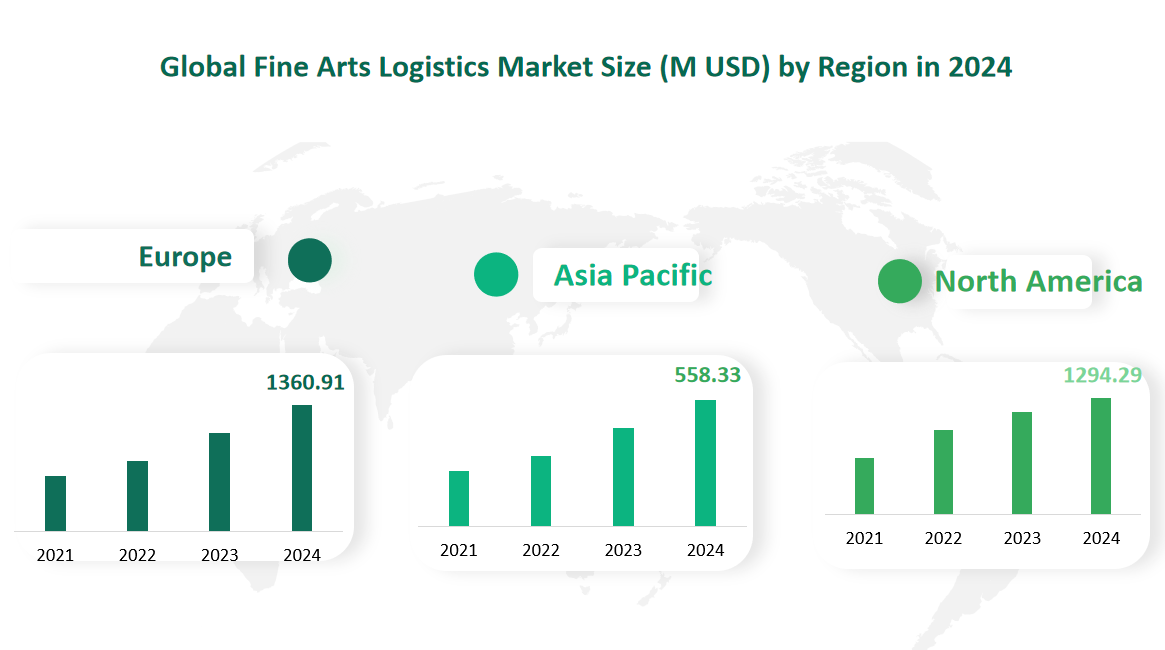1 Global Fine Arts Logistics Market Size (Value) and CAGR (2024-2033)
In 2024, the global Fine Arts Logistics market was valued at USD 3483.01 million, with a CAGR of 6.44% from 2024 to 2033.
Fine Arts Logistics refers to the specialized services required for the handling, packing, transportation, and installation of valuable artworks such as sculptures, paintings, and artifacts. These services are personalized and cater to the unique needs of each piece, ensuring their safe and secure transit. The industry primarily serves art dealers, galleries, auction houses, museums, and art fairs, providing comprehensive logistics solutions tailored to the high-value and fragile nature of the cargo.
Figure Global Fine Arts Logistics Market Size (M USD) and CAGR 2024-2033

2 Fine Arts Logistics Market Key Success Factors and Challenges
Key Success Factors in Fine Arts Logistics Market:
The Fine Arts Logistics market is a niche yet critical segment of the global logistics industry, requiring specialized services to handle the unique challenges associated with the transportation and storage of valuable artworks. Key success factors in this market include the demand for professional services, technological innovation, and the ability to provide personalized solutions.
The growing demand for professional fine art logistics services is a significant success factor, driven by the explosive growth in art auctions and exhibitions. As art becomes an increasingly popular investment and a hedge against inflation, the need for secure and specialized transportation of these valuables is on the rise. Additionally, the rapid development of information technology plays a crucial role, with technologies such as RFID, GPS, and EDI improving efficiency and reducing the information silo problem in logistics operations. These technologies enhance tracking, storage management, and real-time data access, ensuring the safety and integrity of the artwork during transit.
Factors Challenging the Market:
One of the primary barriers is the high entry requirement for art warehousing, which demands substantial investment and specialized knowledge. The diverse and fragile nature of artworks necessitates specific storage conditions, such as controlled temperature and humidity, adding to the complexity and cost of operations. Shipping risks are another significant challenge, with a high percentage of potential damage occurring during transportation. This risk is amplified by the need for tailored packaging and handling protocols for each piece of art. Furthermore, the industry has seen frequent mergers and acquisitions, leading to market concentration and increased competitive pressure on smaller enterprises.
3 Technology Status and Developments in the Fine Arts Logistics Market
From the online trading platform of traditional art institutions to the independent professional platform of different categories, to the addition of large-scale integrated e-commerce and mobile e-commerce, art e-commerce has once again attracted attention. Influenced by multiple factors such as the rise of art e-commerce and the increase in the frequency of exhibition transactions, the demand for fine art logistics services has surged. However, the high professional threshold required for non-standard artworks, especially cultural relics, makes some traditional logistics companies discouraged. But from the market point of view, the demand for mature, professional and perfect fine art logistics services is getting higher and higher.
At the same time, as express companies extend their services to artwork logistics, the business is gradually subdivided. The professionalism of artwork transportation continues to improve. Coupled with the establishment of art warehousing and tripartite cooperation among transportation, warehousing and insurance, the transportation and delivery system for valuables will be improved, and fine art logistics will form a closed-loop industrial chain and usher in a period of rapid development. The use of e-commerce has also reduced the risk of COVID-19 to some extent. Therefore, in the future, the continuous development of art e-commerce will promote the market demand of fine art logistics.
4 Global Fine Arts Logistics Market Size by Type in 2024
The global Fine Arts Logistics market is a dynamic and specialized sector that encompasses a range of services designed to cater to the unique needs of the art industry. This market is segmented by type, including Transportation, Packaging, Storage, and Others, each playing a critical role in the safe and efficient movement of valuable artworks.
Storage: The storage segment is expected to generate a revenue of $713.52 million in 2024. This segment involves the secure and climate-controlled preservation of fine arts, ensuring optimal conditions for the maintenance of the artwork’s integrity. Storage services are crucial for galleries, auction houses, and private collectors who require professional environments to protect their investments.
Transportation: With an estimated revenue of $1,372.02 million in 2024, transportation is a cornerstone of the Fine Arts Logistics market. This service ensures the safe transit of artworks from one location to another, often internationally. It requires specialized vehicles and handling equipment to minimize the risk of damage during transit.
Packaging: The packaging segment is projected to have a revenue of $1,212.13 million in 2024. This involves the use of custom-designed materials and techniques to protect artworks during transportation and storage. Proper packaging is essential to prevent damage and preserve the value of the art.
Table Global Fine Arts Logistics Market Size by Type in 2024
Type | Market Size (M USD) 2024 |
Storage | 713.52 |
Transportation | 1372.02 |
Packaging | 1212.13 |
Others | 185.33 |
5 Global Fine Arts Logistics Market Size by Application in 2024
The Fine Arts Logistics market is segmented into various applications, each with its own unique requirements and market dynamics.
Art Dealers and Galleries: This segment is anticipated to generate the highest revenue, with $1,605.91 million in 2024. Art dealers and galleries require specialized logistics for the acquisition, display, and sale of artworks, which often involves international shipping and high-security measures.
Auction Houses: The auction houses segment is expected to bring in $578.67 million in 2024. Auctions are a significant part of the art market, and the logistics involved in preparing and transporting art for auction events are critical to their success.
Museum and Art Fair: This segment is projected to have a revenue of $1,084.56 million in 2024. Museums and art fairs demand extensive logistics support for the safe transportation and setup of exhibits, which often include priceless and historically significant pieces.
Table Global Fine Arts Logistics Market Size by Application in 2024
Application | Market Size (M USD) 2024 |
Art Dealers and Galleries | 1605.91 |
Auction Houses | 578.67 |
Museum and Art Fair | 1084.56 |
Other | 213.86 |
6 Global Fine Arts Logistics Market Size by Region in 2024
The global Fine Arts Logistics market is diverse, with different regions contributing significantly to the overall market size.
North America: With a revenue of $1,294.29 million in 2024, North America continues to be a significant market, driven by the strong presence of art auctions, galleries, and a robust economy supporting the art market.
Europe: Europe is expected to generate $1,360.91 million in 2024, reflecting its historical significance in the art world and the presence of major art hubs like London and Paris.
Asia Pacific: This region is projected to have a revenue of $558.33 million in 2024, with growing economies and a rising middle class fueling the demand for art and related logistics services.
Latin America: Latin America is expected to contribute $115.29 million in 2024, with countries like Brazil and Mexico showing potential for growth in the art market.
Middle East and Africa: With a revenue of $154.20 million in 2024, this region is seeing increased investment in cultural institutions and a growing interest in the global art market.
Figure Global Fine Arts Logistics Market Size by Region in 2024

7 Major Players in Global Fine Arts Logistics Market
7.1 Crown
Company Profile: Established in 1965, Crown is a UK-based company with a global presence, offering a comprehensive range of services in international assignment management, relocations, information management, workspace design, office relocation, and fine art movement and logistics.
Business Overview: Crown Worldwide Group has emerged as a market leader, providing specialized services such as fine art packing, storage, installation, and shipping. They are known for their expertise in handling high-value and sensitive items, ensuring safe and secure transportation worldwide.
Related Products/Service Introduction: Crown’s offerings include fine art packing and crating, storage in climate-controlled facilities, fine art installation, and specialist fine art logistics advice. They also provide art transport and shipping services, including a European shuttle service.
2023 Financials: Crown reported a revenue of $137.76 million in 2023, with a gross margin of 32.04%.
7.2 hasenkamp
Company Profile: Founded in 1903, hasenkamp is a Germany-based company with a global sales reach, specializing in the transportation and storage of sensitive and high-quality goods, including fine arts.
Business Overview: Hasenkamp is recognized as Europe’s leading logistics service provider, offering a range of services from physical transportation to disassembly, introduction, and assembly of sensitive equipment. They also provide solutions for file storage and document storage.
Related Products/Service Introduction: Hasenkamp’s services for the fine arts sector include the transportation of high-value merchandise and exhibits, with a focus on safety and sustainability. They have also introduced a new reusable art transport system.
2023 Financials: Hasenkamp’s revenue for 2023 was $120.68 million, accompanied by a gross margin of 31.42%.
7.3 DB Schenker
Company Profile: Established in 2007, DB Schenker is a global logistics provider headquartered in Germany, offering land transport, global air and sea freight, contract logistics, and supply chain management services.
Business Overview: DB Schenker supports the global exchange of goods with value-added services that ensure smooth flow and optimized supply chains. They are leaders in various sectors, including automotive, technology, consumer goods, trade fair logistics, special transport, and special event logistics.
Related Products/Service Introduction: In the fine arts logistics sector, DB Schenker offers tailored solutions for museums, galleries, art lovers, and trade fair organizers. Their services include secure transportation, special packaging, customs clearance, and environmental-friendly packaging materials.
2023 Financials: DB Schenker recorded a revenue of $99.27 million in 2023, with a gross margin of 27.20%.

